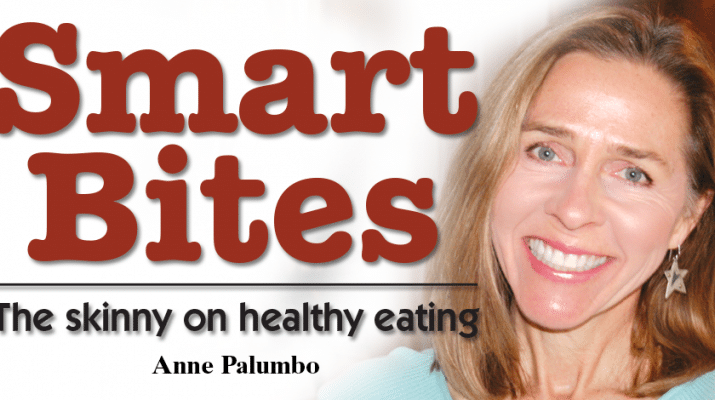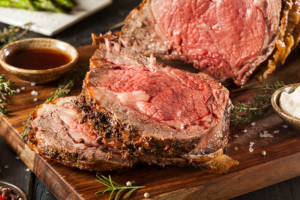By Anne Palumbo
Every December, my husband and I let down our “meat guard” and consume a cut of beef that we rarely eat: prime rib. It’s an indulgence we justify because it’s the holiday, it tastes delicious and, well, you know, it’s what everyone wants.
Apparently, we’re not alone. Prime rib, according to multiple sources, is one of the top 5 meats consumed during the holiday season.
But is it the healthiest meat choice? Oh, probably not. But since many of us do eat it on occasion, here now is everything you ever wanted to know about prime rib (but were afraid to ask).
It can be. Prime rib is a tasty source of many critical nutrients. A 3-oz portion (about the size of a deck of cards) boasts about 20 grams of complete protein, which delivers a decent chunk of recommended daily amounts for many. Essential for building and maintaining tissues and cells, protein also bolsters your immune system, provides energy, and balances fluids.
On the vitamin B front, prime rib rocks with several B vitamins, most specifically B-12 (nearly 100% of your daily needs). Because B-12 is important for red blood cell formation, it’s crucial for the prevention of anemia. One serving of prime rib also contributes good amounts of B-6 and niacin, both needed for turning food into energy.
Prime rib sizzles with minerals, especially selenium, iron and —the most abundant mineral of all — zinc. While zinc fortifies your immune system, selenium protects your body from oxidative stress, and iron keeps your engine running.
Is prime rib bad for me?
Possibly, and here’s why. A 3-oz serving has 300 calories, 72 milligrams of cholesterol and 24 grams of fat (10 of which are saturated fat). Because cholesterol and saturated fat can lead to heart disease, the American Heart Association recommends that we limit our daily consumption of both: cholesterol to 300 milligrams and saturated fat to 20-22 grams. Assuming that “festive” portions might land closer to 6 ounces for many, we could easily knock off a day’s worth of saturated fat and nearly 50% of our cholesterol limit in one sitting. Yikes, and we haven’t even mentioned the 600 calories!
What makes prime rib so darn delicious?
Fat, fat and more fat. The “eye” of meat in prime rib’s center is not only marbled with fat, it has a fat-marbled muscle around it. Moreover, a thick cap of fat surrounds most of the roast. Since the muscles of this cut aren’t heavily used, prime rib is also extremely tender and juicy.
What should I do?
Only you and your heart can answer that. But if you do indulge, experts suggest moderate portions and no seconds
Holiday Prime Rib with Rosemary and Thyme
Serves 10 — Adapted from tastesbetterfromscratch.com
5 pounds beef prime rib: bone-in or boneless
3½ teaspoons Kosher salt, divided
2 teaspoons coarse black pepper
2 teaspoons fresh rosemary
1 teaspoon fresh thyme
8 cloves garlic , minced
¼ cup olive oil
horseradish (optional)
Remove your prime rib from the refrigerator one hour before cooking. Season it on all sides with 2 teaspoons salt and cover it loosely with plastic wrap as it comes to room temperature.
Place oven rack in the center and preheat oven to 500 degrees F.
Mix together 1½ teaspoons salt, pepper, rosemary, thyme, garlic, and olive oil. Pat the roast with paper towels. Spoon seasoning over it, rubbing it onto all sides.
Place the roast bone-side down in a roasting pan. If using boneless, place the roast on a rack inside the pan. Insert an ovenproof thermometer into the thickest part of the roast.
Brown the roast at 500 degrees for 15 minutes, then reduce the oven temperature to 325 degrees and roast for another 20-30 minutes until the thermometer reaches 125 degrees for rare/medium rare (roast will continue to cook slightly after removing from the oven). If you like your meat more cooked, leave it in the oven longer.
Remove roast from the oven and tent it with foil. Allow it to rest for 20 minutes before carving. Carve your roast by slicing against the grain at about 1/2 inch thickness. Serve with horseradish, if desired.
 Anne Palumbo is a lifestyle columnist, food guru, and seasoned cook, who has perfected the art of preparing nutritious, calorie-conscious dishes. She is hungry for your questions and comments about SmartBites, so be in touch with Anne at avpalumbo@aol.com.
Anne Palumbo is a lifestyle columnist, food guru, and seasoned cook, who has perfected the art of preparing nutritious, calorie-conscious dishes. She is hungry for your questions and comments about SmartBites, so be in touch with Anne at avpalumbo@aol.com.


